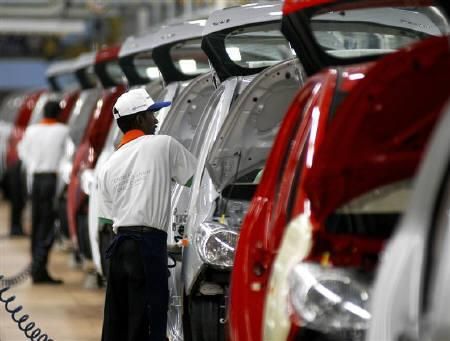 The rebound in the April-June 2014 quarter has given economy-watchers hope that the worst is over.
The rebound in the April-June 2014 quarter has given economy-watchers hope that the worst is over.
The country's gross domestic product (GDP) grew by around 5.7 per cent in April-June 2014, compared to April-June 2013.
A look at the nature of the GDP growth rate suggests some of it may have been due to temporary effects such as higher government spending and the impact of huge election-related spending.
However, everybody is hoping that sentiment would have turned around and one strong quarter would translate into sustained consumption demand.
One of the best ways of judging the overall economic health is through the auto industry's fortunes. Automobiles and two-wheelers are big-ticket buys for individual and indicative of economic confidence.
Strong commercial vehicles sales (three-wheelers, trucks, buses) are also good indicators of economic activity.
The auto value chain is very long and pretty much encompasses the entire economy.
It starts with basic commodities since auto manufacture stimulates demand for steel, aluminium, chrome, plastics, fibreglass composites, special glasses, etc.
An auto also includes many highly sophisticated electronics gadgets and complex engine parts and specialised smart chips. There are all the accessories.
There are the maintenance and repair functions post-sales. At the services end, sophisticated financing is also involved.
The auto industry needs large amounts of working capital as well as huge dollops of capital investment. Consumers need to be financed.
Plus there are tertiary services like marketing and advertising. As a result, when the auto industry is doing well, the entire economy tends to be doing well.
The numbers are not very good now. According to the SIAM, across April-July 2014, passenger vehicle sales units grew only by 2.5 per cent over April-July 2013.
However, July saw some improvement. Over April-June 2014, sales rose just 1.3 per cent versus sales in April-June 2013.
The Commercial Vehicles (CV) segment registered a big fall of minus 15.51 per cent across April-July 2014 compared to April-July 2013.
Medium and heavy commercial vehicles registered growth of minus 8.50 per cent and light commercial vehicles shrank by 19.02 per cent. However, two-wheelers grew by 13.7 per cent and three-wheelers grew by 15 per cent.
Exports grew considerably. In April-July 2014, overall automobile exports grew by 23.17 percent over the same period last year. Exports grew across all segments.
Passenger vehicles, commercial vehicles, three-wheelers and two-wheelers grew by 3.84 per cent, 19.78 per cent, 5.27 per cent and 32.72 per cent, respectively.
The August numbers show that Maruti has done very well with a 28 per cent rise in unit sales. Hyundai also reported 19 per cent growth.
However, Tata Motors reported a negative sales trend. Maruti may have benefited from the prevailing trend in fuel prices.
Petrol prices are reducing while diesel prices are being hiked and Maruti's portfolio is petrol-driven.
The sales numbers don't seem to support the enthusiasm obvious in the sector.
However, after two years of recession, auto industry analysts think there has been a turnaround in sentiment.
They are hoping that the upcoming festive season will see that translate into better numbers.
If global crude prices remain low, this would probably boost sentiment. However, a sub-par monsoon may be a dampener to semi-urban demand.
Another key to demand is inflation. Inflation translates into high interest rates, which in turn, affects equated monthly instalment (EMI) payments.
EMIs are high if interest rates are high and the vast majority of vehicles are bought on hire-purchase. The Reserve Bank of India has more or less indicated that it doesn't really want to cut rates until January 2015. The numbers are inconclusive. But it does seem that July and August saw positive growth.
For an industry which saw sales shrinking in 2013-14, this is hope indeed.
If this is the start of a reversal in the auto-industry cycle, it could be the start of a long uptrend.
Photograph: Babu/Reuters










